6_November_CreativeC_IATEFL-talk-ppt-slides_Final1
Download as pptx, pdf0 likes94 views
The document discusses an Erasmus+ K1 Mobility program organized by I.L.I. Kft. It introduces the program and provides resources for teachers, including websites about Erasmus+, skill-building classroom activities to encourage cooperation, and techniques for vocabulary learning using word cards. Contact information is given for I.L.I.'s Erasmus+ project and social media pages.
1 of 23
Download to read offline
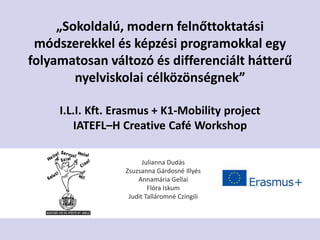
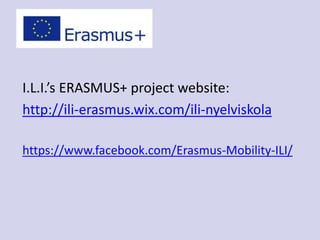

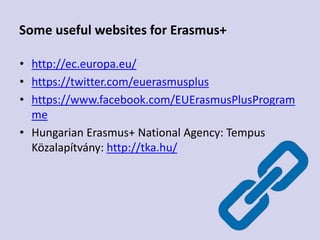
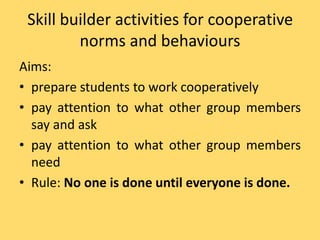
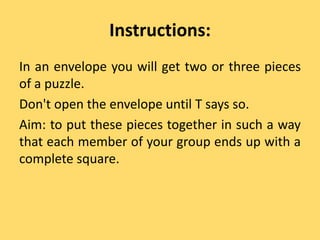
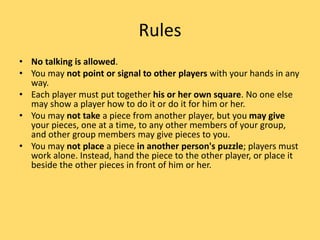
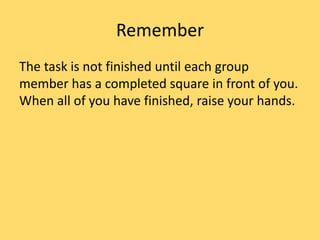
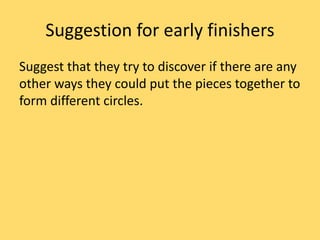
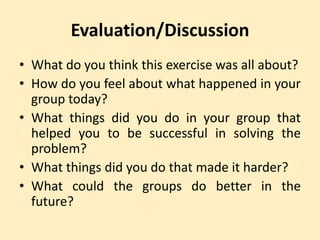



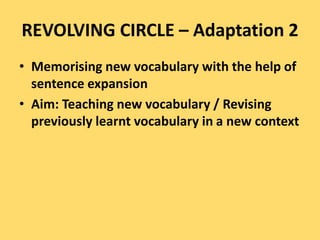
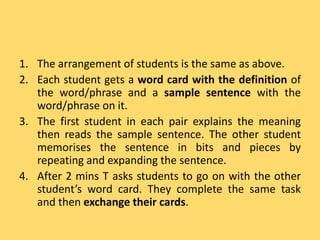

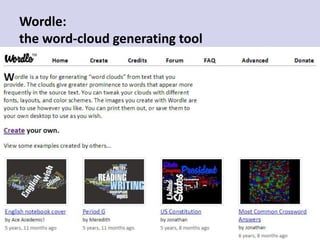
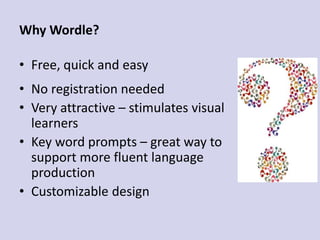
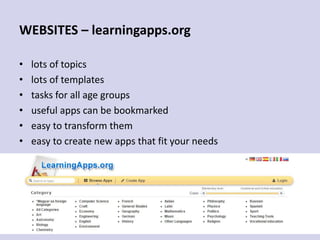
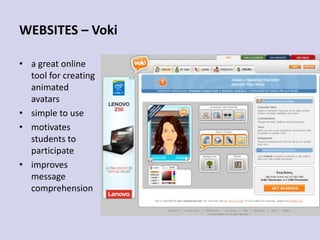



Ad
Recommended
Scaffolding
ScaffoldingIrina K
╠²
The document discusses scaffolding language instruction. It begins with an agenda and introduction of the presenter. Scaffolding is then defined as temporary support that helps students develop new language skills, relating it to Vygotsky's zone of proximal development. An example is given of a father scaffolding his son's storytelling about visiting the zoo. Various scaffolding techniques are presented, including reducing degrees of freedom, message abundance, and joint construction of dialogues. The presentation concludes with a discussion of scaffolding activities teachers can use in the classroom.FLIPPED CLASSROOM GROUP 3
FLIPPED CLASSROOM GROUP 3Raquel Uriel Molinat
╠²
This document outlines a lesson plan for a unit on forces and movements. The objectives are for students to learn basic concepts of forces and movements, work cooperatively, and be respectful. Students will watch videos, take notes, apply knowledge in activities, understand how machines help with tasks, and construct and manipulate objects. Competencies covered include linguistic, science, art, and social skills. Assessment involves observing students work in groups, communicate ideas, understand concepts, be creative, and behave respectfully. A quiz game is designed to test concept understanding and promote cooperation.Olesia Nikolayevych and Yulia Mishko. 21 keys to capture 21st century student...
Olesia Nikolayevych and Yulia Mishko. 21 keys to capture 21st century student...Grade Education Centre (Kyiv)
╠²
This document provides 21 techniques for capturing students' attention in the 21st century. It discusses how todays students, known as Generation Z, are more distracted than previous generations due to constant digital stimulation and access to information. Some key techniques mentioned include using voice modulation, visual aids, ensuring tasks are at an appropriate level, establishing routines, incorporating projects, gamification, interactivity, keeping instruction dynamic and brisk, providing feedback, and understanding students. The document stresses the importance of immersing students in experiences and adapting teaching styles to todays hyper-connected, impatient students.How to motivate teachers to get into eTwinning?
How to motivate teachers to get into eTwinning?Rita Zurrapa
╠²
The document outlines a workshop led by Rita Zurrapa focused on motivating teachers through sharing experiences, discussing practices, and collaborating on effective teaching methods. It emphasizes the need for teachers to adapt to 21st-century demands and incorporate engaging methodologies that resonate with students. Key points include the importance of empathy, recognizing teachers' contributions, and using eTwinning projects to enhance collaboration and real-world connections.TEACHERS' CONFERENCE by GRADE || 50 shades of motivation Lana Sushko
TEACHERS' CONFERENCE by GRADE || 50 shades of motivation Lana SushkoVera Novikova
╠²
The document contains motivational insights for educators, emphasizing the importance of emotional connections, encouragement, and understanding students' needs. It offers practical strategies for teachers to prepare lessons and manage classroom challenges effectively. Additionally, it provides resources for professional development and fostered connections with colleagues.Irene Sushko. The power of habit. (Teachers' Conference by Grade 2019)
Irene Sushko. The power of habit. (Teachers' Conference by Grade 2019)Grade Education Centre (Kyiv)
╠²
The document discusses effective strategies for good language learners, emphasizing the importance of setting achievable goals, understanding personal learning preferences, and taking responsibility for their education. It outlines various activities and practices that foster communication, encourage practice, and promote self-monitoring and reflection. Additionally, the document provides resources and activities to facilitate improved language learning in a collaborative and engaging manner.group 3
group 3Raquel Uriel Molinat
╠²
This document outlines a lesson plan on forces and movements for 5th grade primary students. It includes general and specific objectives, such as learning basic concepts of forces and movements and applying knowledge through activities. Students will watch two videos on the topic, complete a criss-cross activity, give presentations, play games involving flash cards and riddles, and be evaluated on their collaboration, creativity, and understanding of concepts. The lesson incorporates different learning styles and aims to develop students' linguistic, science, art, and social competences.32 interesting ways_to_use_wallwisher
32 interesting ways_to_use_wallwisherUHPS
╠²
This document lists 32 ways that the educational tool Wallwisher can be used in the classroom. Some examples include collecting student ideas and feedback, giving assignments, showcasing student work, book reviews, international greetings, and creating matching exercises. The tips are provided by teachers and suggest embedding Wallwisher content into learning platforms and using it for independent writing, cooking lessons, and more. Contributors are encouraged to add their own ideas and share the resource.Funwith foldables #pedagoolondon
Funwith foldables #pedagoolondonKDWScience
╠²
This document discusses different active learning strategies including "Find Someone Who...", "Quiz Quiz Trade", and foldables. It provides examples of how foldables can be used, such as for revision, organizing knowledge, and assessing learning. Different foldable shapes are described like tacos, mountains, and hamburgers. Resources for making and finding foldables are included, as well as examples of student work. The document encourages teachers to make their own foldables for topics to share ideas.Inga sharadze module 2 observation
Inga sharadze module 2 observationsharadze
╠²
The lesson plan contained clearly stated objectives and activities that scaffolded students' knowledge and skills toward achieving the objective. The lesson was learner-centered through the use of choices, group work, and a student-appointed leader. However, there were too many activities, which caused students to lose focus on the objective. The teacher recognized that she tried to incorporate too much material and needed to refocus students on the core activity rather than having so many distracting elements.4 Dumrauf Johanna - Clase practica 3 - Practica docente I
4 Dumrauf Johanna - Clase practica 3 - Practica docente IJohannaDumrauf
╠²
This lesson plan is for an English class of 11 students aged 5-7. The lesson will focus on teaching vocabulary related to summer weather like sunny, rainy, windy and snowy. There will be two activities - a skipping game to review the vocabulary and a cut and paste activity where students match weather pictures to the words. The plan aims to develop students' vocabulary, listening, visual and interpersonal skills over a 60 minute period through interactive games and individual work.How to motivate eTwinning teachers
How to motivate eTwinning teachers Rita Zurrapa
╠²
The document outlines an workshop on how to motivate teachers. The workshop aims to share experiences, discuss collaboration and best practices. It encourages participation and sharing. Several questions are posed to prompt discussion on motivating and engaging teachers. Resources on 21st century education and teaching are shared, highlighting the need for student-centered learning and engaging teachers in their own professional development. The workshop promotes collaboration through eTwinning projects to motivate teachers.Pohatu2013 meettheteacher
Pohatu2013 meettheteachernikkijelangford
╠²
This document provides information for parents about routines and expectations for students in the Pohatu Learning Community at Remarkables Primary School. It outlines morning and afternoon routines, parent procedures, the school timetable including literacy, numeracy, inquiry learning and performing arts/PE. It also discusses communication methods and learning beyond the classroom. Reflection time is held on Fridays to discuss the school values and learning from the week.Friday briefing s&c wall
Friday briefing s&c wallbdavis2014
╠²
This document provides suggestions for how to use a "Stretch and Challenge Wall" in the classroom. It can be used as an extension activity after initial lessons, as a review at the end of class, for mini-reviews during class, for group challenges, and for paired activities. It also encourages teachers to write down how they have used their wall on post-it notes, discuss different uses with other teachers, and record new potential uses to try in the future.Learner profiles
Learner profilesannastewart1212
╠²
1) The document discusses strategies for teaching a unit on robots to students and developing important learner profiles.
2) Suggestions include having students interview adults about how robots could help or hurt humanity, keeping diaries on how robots could influence daily life, and holding debates about benefits of a world with robots.
3) Assessments are proposed such as student presentations on pros and cons of robots' influence on society and allowing student choice in final assessments like presentations, papers, or diagrams.Erinlansberry theory
Erinlansberry theoryelansberry
╠²
The document discusses constructivism as a learning theory where students actively construct knowledge through their experiences. Key figures who contributed to constructivism include Vygotsky, Piaget, Dewey, and Bruner. According to the theory, teachers should allow students to lead activities and experiments to build their own understanding, while using technology like simulations and interactive whiteboards. Students are encouraged to work collaboratively on hands-on projects and solve problems themselves.Portfolio presentation
Portfolio presentationAil├®n Bailo
╠²
This document summarizes Ail├®n Bailo's learning process as a student teacher. It describes challenges faced with students not being interested in certain subjects. It discusses how group assignments do not always work and the importance of finding ways to engage students. The document concludes that this is just the beginning of Ail├®n's learning journey as a teacher, that mistakes will help her grow, and that she will continue learning from her teachers and students.Sunshine Coast.int.sec.reading.may2014
Sunshine Coast.int.sec.reading.may2014Faye Brownlie
╠²
The document provides details about evidence-based reading practices being implemented by teachers in collaboration at various schools. It describes how teachers work together to create focused plans, conduct quick checks of student understanding daily, and divide classes in half to provide more individual support during inquiry projects where students research topics of their choosing and share their learning. Collaboration allows teachers to better meet student needs through smaller grouping and shared planning, preparation and learning.Teacher Collaboration
Teacher CollaborationChinese Teachers
╠²
The document summarizes teacher collaboration at Queens High School for Language Studies. It discusses intra-department and cross-department collaboration including intervisitation where teachers observe each other's classrooms. During intervisitation, teachers take low-inference notes focused on evidence of student learning and use a debrief protocol to provide constructive feedback. Cross-department meetings aim to align standards, curriculum, and expectations across subjects. Intra-department collaboration includes analyzing student data and test preparation. Setting norms and assigning roles helps make collaboration more effective.Assessment
Assessmentkatherinedouglas
╠²
The document discusses various methods for observing and assessing student progress in art education, emphasizing the importance of both visual documentation and student involvement. It highlights the use of photography, video recordings, and surveys to track and enhance student engagement and reflection on their work. Additionally, it describes strategies for maintaining records and improving observation techniques to better tailor instruction to student needs.Flattening the Page - NWP
Flattening the Page - NWPKevin Hodgson
╠²
The document summarizes a project where students created digital picture books that incorporated math concepts. Students worked collaboratively with teachers of different subjects over multiple weeks to write, illustrate, and publish their books. They shared their books with younger students and reflected on using technology to create an interactive medium compared to a traditional printed book.Working Memory and Learning Workshop - Susan Gathercole
Working Memory and Learning Workshop - Susan GathercoleSwiss Cottage Development and Research Centre
╠²
This document discusses working memory and its importance for learning in the classroom. It describes working memory as a limited mental workspace that allows temporary storage and manipulation of information. The document explains that working memory is crucial for following instructions, maintaining task goals, and sequential learning activities in school. Children with weak working memory often struggle in classroom situations with high memory demands. The document proposes several strategies a teacher could use to support such students, such as providing memory aids, breaking tasks into smaller steps, and directly training working memory skills.Assignment4a
Assignment4aJana Meehan
╠²
This document provides ideas for using technology in an ESL classroom, including creating a class blog for students to share writing and pictures in their native language, making word of the day videos or illustrations, creating PowerPoint presentations on topics like planets or animals, designing a class webpage to share student work and links, using online research tools like Wikipedia, and finding educational videos on YouTube to supplement lessons. The goal is to engage students through fun technology activities that also support language learning.Connecting With Students
Connecting With Studentshopeadrianne
╠²
The document provides strategies for teachers to connect with students on a personal, academic, and social level. Some strategies for personal connection include collecting student index cards, greeting students in the hallway, being at the classroom door to greet students, and offering notes of appreciation. Academic connection strategies involve taking photos of students working on projects, asking open-ended questions of nonparticipating students, providing adequate wait time, making mistakes to show students it's okay, and displaying student work. Finally, social connection strategies include letting students make some classroom rules, agreeing to change rules if students provide alternatives, encouraging "complaint letters," getting involved as volunteers, and sharing food together.PBL 101: The PBL Experience Day 1 Presentation
PBL 101: The PBL Experience Day 1 PresentationRhitt Growl
╠²
This document outlines the itinerary and objectives for Day 1 of a PBL 101 workshop. The itinerary includes sessions on understanding PBL and the PBL process, developing a project idea, and identifying an authentic challenge. Participants will work in groups to analyze a video using a 3-2-1 strategy, discuss the differences between projects and PBL, and give feedback on their learning using a self-evaluation rubric. The overall goals are for teachers to gain strategies for incorporating PBL in their classrooms in a way that engages students and connects to real-world issues.Parent welcome meeting sept 2103
Parent welcome meeting sept 2103raygaff
╠²
This document provides information for parents about Year 2 at Dobcroft Infant School. It includes:
1. An introduction to the Year 2 teachers and teaching assistants.
2. An overview of the Year 2 curriculum, which includes areas like numeracy, literacy, science, and more. Assessments are moderated by the Year 2 team.
3. Information about routines for the school day, homework, reading, communication with teachers, and other policies.Clil valladolid session_3_sunday
Clil valladolid session_3_sundayLaura Riesco
╠²
The document outlines an agenda for a professional development session on contextualization and diversification in social sciences, including using various digital tools and interactive activities to reinforce vocabulary, review concepts, and develop students' communicative skills through information gap activities, games, and role-playing group work assignments.Improv Games for the ESL Classroom
Improv Games for the ESL ClassroomCharlotte Jones
╠²
The document provides descriptions and instructions for several improvisation activities that can be used in an ESL classroom, including:
1) Clap Around, which builds attentive listening and trust through passing a clap between students in a circle.
2) The Name Game, where students learn each other's names through gestures and repetition.
3) Zip Zap Zop, an improv staple that develops listening through call-and-response.
4) Patterns and Convergence, which activate vocabulary through collaborative storytelling and guessing related words.
5) "Yes, And..." stories that build on others' ideas through accepting and adding on to a shared narrative.
The goals of these activities areActivity based practices for english language proficiency
Activity based practices for english language proficiencySAISH NAYAK DALAL
╠²
This document outlines 8 language activities to develop English proficiency through critical thinking, creative thinking, and speaking skills. The activities include introducing objects, describing pictures, roleplaying conversations, brainstorming words related to communication skills, guessing identities, creating stories from prompts, analyzing newspaper articles, and solving crossword puzzles. The instructor's role is to correct mistakes, suggest synonyms and antonyms, and point out errors. The expected outcomes are improved language proficiency, communication skills, confidence, participation, thinking skills, interest in learning English, and additional knowledge beyond the syllabus.TT_12Oct2015_Workshop_handout_TCJ
TT_12Oct2015_Workshop_handout_TCJJudit Tall├Īromn├® Czingili
╠²
This document summarizes a teacher training event about modern methods for diverse language school students. It was supported by the European Union.
The event included two presentations on interactive learning methods:
1) "Revolving Circle" - A cooperative learning method where students discuss topics in rotating pairs, allowing them to consider different views.
2) Using "Revolving Circle" to memorize new vocabulary by having students explain definitions and sample sentences, then expand on the sentences in turn.
The goal was to provide teachers varied, student-centered techniques for a changing student population.More Related Content
What's hot (18)
Funwith foldables #pedagoolondon
Funwith foldables #pedagoolondonKDWScience
╠²
This document discusses different active learning strategies including "Find Someone Who...", "Quiz Quiz Trade", and foldables. It provides examples of how foldables can be used, such as for revision, organizing knowledge, and assessing learning. Different foldable shapes are described like tacos, mountains, and hamburgers. Resources for making and finding foldables are included, as well as examples of student work. The document encourages teachers to make their own foldables for topics to share ideas.Inga sharadze module 2 observation
Inga sharadze module 2 observationsharadze
╠²
The lesson plan contained clearly stated objectives and activities that scaffolded students' knowledge and skills toward achieving the objective. The lesson was learner-centered through the use of choices, group work, and a student-appointed leader. However, there were too many activities, which caused students to lose focus on the objective. The teacher recognized that she tried to incorporate too much material and needed to refocus students on the core activity rather than having so many distracting elements.4 Dumrauf Johanna - Clase practica 3 - Practica docente I
4 Dumrauf Johanna - Clase practica 3 - Practica docente IJohannaDumrauf
╠²
This lesson plan is for an English class of 11 students aged 5-7. The lesson will focus on teaching vocabulary related to summer weather like sunny, rainy, windy and snowy. There will be two activities - a skipping game to review the vocabulary and a cut and paste activity where students match weather pictures to the words. The plan aims to develop students' vocabulary, listening, visual and interpersonal skills over a 60 minute period through interactive games and individual work.How to motivate eTwinning teachers
How to motivate eTwinning teachers Rita Zurrapa
╠²
The document outlines an workshop on how to motivate teachers. The workshop aims to share experiences, discuss collaboration and best practices. It encourages participation and sharing. Several questions are posed to prompt discussion on motivating and engaging teachers. Resources on 21st century education and teaching are shared, highlighting the need for student-centered learning and engaging teachers in their own professional development. The workshop promotes collaboration through eTwinning projects to motivate teachers.Pohatu2013 meettheteacher
Pohatu2013 meettheteachernikkijelangford
╠²
This document provides information for parents about routines and expectations for students in the Pohatu Learning Community at Remarkables Primary School. It outlines morning and afternoon routines, parent procedures, the school timetable including literacy, numeracy, inquiry learning and performing arts/PE. It also discusses communication methods and learning beyond the classroom. Reflection time is held on Fridays to discuss the school values and learning from the week.Friday briefing s&c wall
Friday briefing s&c wallbdavis2014
╠²
This document provides suggestions for how to use a "Stretch and Challenge Wall" in the classroom. It can be used as an extension activity after initial lessons, as a review at the end of class, for mini-reviews during class, for group challenges, and for paired activities. It also encourages teachers to write down how they have used their wall on post-it notes, discuss different uses with other teachers, and record new potential uses to try in the future.Learner profiles
Learner profilesannastewart1212
╠²
1) The document discusses strategies for teaching a unit on robots to students and developing important learner profiles.
2) Suggestions include having students interview adults about how robots could help or hurt humanity, keeping diaries on how robots could influence daily life, and holding debates about benefits of a world with robots.
3) Assessments are proposed such as student presentations on pros and cons of robots' influence on society and allowing student choice in final assessments like presentations, papers, or diagrams.Erinlansberry theory
Erinlansberry theoryelansberry
╠²
The document discusses constructivism as a learning theory where students actively construct knowledge through their experiences. Key figures who contributed to constructivism include Vygotsky, Piaget, Dewey, and Bruner. According to the theory, teachers should allow students to lead activities and experiments to build their own understanding, while using technology like simulations and interactive whiteboards. Students are encouraged to work collaboratively on hands-on projects and solve problems themselves.Portfolio presentation
Portfolio presentationAil├®n Bailo
╠²
This document summarizes Ail├®n Bailo's learning process as a student teacher. It describes challenges faced with students not being interested in certain subjects. It discusses how group assignments do not always work and the importance of finding ways to engage students. The document concludes that this is just the beginning of Ail├®n's learning journey as a teacher, that mistakes will help her grow, and that she will continue learning from her teachers and students.Sunshine Coast.int.sec.reading.may2014
Sunshine Coast.int.sec.reading.may2014Faye Brownlie
╠²
The document provides details about evidence-based reading practices being implemented by teachers in collaboration at various schools. It describes how teachers work together to create focused plans, conduct quick checks of student understanding daily, and divide classes in half to provide more individual support during inquiry projects where students research topics of their choosing and share their learning. Collaboration allows teachers to better meet student needs through smaller grouping and shared planning, preparation and learning.Teacher Collaboration
Teacher CollaborationChinese Teachers
╠²
The document summarizes teacher collaboration at Queens High School for Language Studies. It discusses intra-department and cross-department collaboration including intervisitation where teachers observe each other's classrooms. During intervisitation, teachers take low-inference notes focused on evidence of student learning and use a debrief protocol to provide constructive feedback. Cross-department meetings aim to align standards, curriculum, and expectations across subjects. Intra-department collaboration includes analyzing student data and test preparation. Setting norms and assigning roles helps make collaboration more effective.Assessment
Assessmentkatherinedouglas
╠²
The document discusses various methods for observing and assessing student progress in art education, emphasizing the importance of both visual documentation and student involvement. It highlights the use of photography, video recordings, and surveys to track and enhance student engagement and reflection on their work. Additionally, it describes strategies for maintaining records and improving observation techniques to better tailor instruction to student needs.Flattening the Page - NWP
Flattening the Page - NWPKevin Hodgson
╠²
The document summarizes a project where students created digital picture books that incorporated math concepts. Students worked collaboratively with teachers of different subjects over multiple weeks to write, illustrate, and publish their books. They shared their books with younger students and reflected on using technology to create an interactive medium compared to a traditional printed book.Working Memory and Learning Workshop - Susan Gathercole
Working Memory and Learning Workshop - Susan GathercoleSwiss Cottage Development and Research Centre
╠²
This document discusses working memory and its importance for learning in the classroom. It describes working memory as a limited mental workspace that allows temporary storage and manipulation of information. The document explains that working memory is crucial for following instructions, maintaining task goals, and sequential learning activities in school. Children with weak working memory often struggle in classroom situations with high memory demands. The document proposes several strategies a teacher could use to support such students, such as providing memory aids, breaking tasks into smaller steps, and directly training working memory skills.Assignment4a
Assignment4aJana Meehan
╠²
This document provides ideas for using technology in an ESL classroom, including creating a class blog for students to share writing and pictures in their native language, making word of the day videos or illustrations, creating PowerPoint presentations on topics like planets or animals, designing a class webpage to share student work and links, using online research tools like Wikipedia, and finding educational videos on YouTube to supplement lessons. The goal is to engage students through fun technology activities that also support language learning.Connecting With Students
Connecting With Studentshopeadrianne
╠²
The document provides strategies for teachers to connect with students on a personal, academic, and social level. Some strategies for personal connection include collecting student index cards, greeting students in the hallway, being at the classroom door to greet students, and offering notes of appreciation. Academic connection strategies involve taking photos of students working on projects, asking open-ended questions of nonparticipating students, providing adequate wait time, making mistakes to show students it's okay, and displaying student work. Finally, social connection strategies include letting students make some classroom rules, agreeing to change rules if students provide alternatives, encouraging "complaint letters," getting involved as volunteers, and sharing food together.PBL 101: The PBL Experience Day 1 Presentation
PBL 101: The PBL Experience Day 1 PresentationRhitt Growl
╠²
This document outlines the itinerary and objectives for Day 1 of a PBL 101 workshop. The itinerary includes sessions on understanding PBL and the PBL process, developing a project idea, and identifying an authentic challenge. Participants will work in groups to analyze a video using a 3-2-1 strategy, discuss the differences between projects and PBL, and give feedback on their learning using a self-evaluation rubric. The overall goals are for teachers to gain strategies for incorporating PBL in their classrooms in a way that engages students and connects to real-world issues.Parent welcome meeting sept 2103
Parent welcome meeting sept 2103raygaff
╠²
This document provides information for parents about Year 2 at Dobcroft Infant School. It includes:
1. An introduction to the Year 2 teachers and teaching assistants.
2. An overview of the Year 2 curriculum, which includes areas like numeracy, literacy, science, and more. Assessments are moderated by the Year 2 team.
3. Information about routines for the school day, homework, reading, communication with teachers, and other policies.Working Memory and Learning Workshop - Susan Gathercole
Working Memory and Learning Workshop - Susan GathercoleSwiss Cottage Development and Research Centre
╠²
Similar to 6_November_CreativeC_IATEFL-talk-ppt-slides_Final1 (20)
Clil valladolid session_3_sunday
Clil valladolid session_3_sundayLaura Riesco
╠²
The document outlines an agenda for a professional development session on contextualization and diversification in social sciences, including using various digital tools and interactive activities to reinforce vocabulary, review concepts, and develop students' communicative skills through information gap activities, games, and role-playing group work assignments.Improv Games for the ESL Classroom
Improv Games for the ESL ClassroomCharlotte Jones
╠²
The document provides descriptions and instructions for several improvisation activities that can be used in an ESL classroom, including:
1) Clap Around, which builds attentive listening and trust through passing a clap between students in a circle.
2) The Name Game, where students learn each other's names through gestures and repetition.
3) Zip Zap Zop, an improv staple that develops listening through call-and-response.
4) Patterns and Convergence, which activate vocabulary through collaborative storytelling and guessing related words.
5) "Yes, And..." stories that build on others' ideas through accepting and adding on to a shared narrative.
The goals of these activities areActivity based practices for english language proficiency
Activity based practices for english language proficiencySAISH NAYAK DALAL
╠²
This document outlines 8 language activities to develop English proficiency through critical thinking, creative thinking, and speaking skills. The activities include introducing objects, describing pictures, roleplaying conversations, brainstorming words related to communication skills, guessing identities, creating stories from prompts, analyzing newspaper articles, and solving crossword puzzles. The instructor's role is to correct mistakes, suggest synonyms and antonyms, and point out errors. The expected outcomes are improved language proficiency, communication skills, confidence, participation, thinking skills, interest in learning English, and additional knowledge beyond the syllabus.TT_12Oct2015_Workshop_handout_TCJ
TT_12Oct2015_Workshop_handout_TCJJudit Tall├Īromn├® Czingili
╠²
This document summarizes a teacher training event about modern methods for diverse language school students. It was supported by the European Union.
The event included two presentations on interactive learning methods:
1) "Revolving Circle" - A cooperative learning method where students discuss topics in rotating pairs, allowing them to consider different views.
2) Using "Revolving Circle" to memorize new vocabulary by having students explain definitions and sample sentences, then expand on the sentences in turn.
The goal was to provide teachers varied, student-centered techniques for a changing student population.Differentiate or disengage?
Differentiate or disengage?MLTA of NSW
╠²
Differentiating instruction in the language classroom is important to engage all students and cater for varying ability levels. There are several ways to differentiate, including by support, text, task, ability, and interest. Differentiation strategies include using scaffolding techniques to modify texts, grouping students heterogeneously and homogenously, providing choice in activities, and varying student outcomes and assessments. Proper planning, resources, and questioning techniques are needed to effectively implement differentiation in the language classroom.How to make the LOTE classroom more engaging & communicative
How to make the LOTE classroom more engaging & communicativedesalynn
╠²
The document provides ideas for making the foreign language classroom more engaging and communicative, including conducting meaningful speaking, writing, listening and reading activities throughout the day and using techniques like circumlocution, beach ball conversations, see-tell-draw, and journaling to promote student interaction and language use. It also discusses the goals of developing intermediate language skills rather than native-like ability and using activities that hold students accountable for their learning through paired exercises.DEMO-TEACHING values education 123456789
DEMO-TEACHING values education 123456789EuniceVillanueva9
╠²
The document outlines various interactive teaching strategies to engage students actively in the learning process, including group games, brainstorming sessions, and peer review activities. It emphasizes the importance of student interaction, using techniques like think-pair-share and forced debates to foster discussion and critical thinking. Additionally, it provides a quiz and correction key related to the teaching strategies mentioned.Developing a Well Balanced Class- The Four Strand Approach and Top Activities...
Developing a Well Balanced Class- The Four Strand Approach and Top Activities...Compass Publishing
╠²
The document outlines a comprehensive approach to language instruction using a four-strand theory: meaning-focused input, meaning-focused output, language-focused learning, and fluency development. It emphasizes a balanced focus on these strands to enhance English language teaching, particularly for elementary students. Additionally, it introduces the 'Hang Out!' coursebook, detailing its structure and the resources available for both students and teachers.3 core elements clil
3 core elements clilJes├║s ├üngel Gonz├Īlez L├│pez
╠²
This document provides an overview of Content and Language Integrated Learning (CLIL). It defines CLIL as a dual-focused approach using two languages to promote both content mastery and language acquisition. The document discusses types of CLIL, classroom activities, language requirements, genres, resources, teacher responsibilities, and potential problems. It also summarizes the Hungarian approach to CLIL which provides extensive exposure through primary and secondary school with requirements for teacher qualifications and ongoing training.CLIL_by_Jon_Wright
CLIL_by_Jon_WrightServei de Lleng├╝es Estrangeres
╠²
The document discusses the implementation of CLIL (Content and Language Integrated Learning) in educational settings, highlighting its benefits, methods, and challenges. It emphasizes the importance of engaging learners, creating a supportive classroom environment, and utilizing effective teaching strategies to enhance language and content learning. Additionally, the document outlines suggested action plans for teachers to integrate CLIL practices and encourage student participation.Tesol Seminar Questions
Tesol Seminar Questionsthuy.lebich
╠²
1) The document outlines 10 speaking activities for an English language classroom including discussions, role plays, guessing games, and tongue twisters.
2) It also includes instructions for completing the activities in groups or pairs and evaluating student performance based on accuracy or fluency.
3) Resources for additional activities and rubrics for assessment are provided.Tesol Seminar
Tesol Seminar Letizia Cinganotto
╠²
1) The document outlines 10 speaking activities for an English language classroom including discussions, role plays, guessing games, and tongue twisters.
2) It also provides examples of accuracy-focused and fluency-focused classroom speaking activities as well as websites with additional resources like discussions questions, crossword puzzles, and rubrics for evaluating student speaking.
3) The activities aim to integrate skills like reading, writing, and listening while practicing grammar, vocabulary, and pronunciation.Classroom Activities - Chapter 2
Classroom Activities - Chapter 2Institude of applied science technology Jahad Daneshgahi (UASTJD)
╠²
1. The document discusses planning activities for language lessons. An activity involves learners using language to achieve a specific outcome.
2. Activities can involve individual work, pairwork, small group work, or whole class work. Pair and group work are common to provide opportunities for students to practice using language.
3. A basic route map for running an activity includes preparing materials, introducing the activity, setting up groups, monitoring the activity, providing feedback, and following up. Variations allow for checking answers or comparing responses in groups.SIOP Interaction
SIOP InteractionStacyschneider
╠²
(1) Providing opportunities for interaction is important for effective learning as it allows students to discuss ideas, practice speaking skills, and solidify their own understanding. (2) Teachers should vary grouping configurations, such as whole class, partners, and small groups, to maintain student interest and involve more students. (3) Cooperative learning activities like jigsaw readings and information gap activities promote collaboration and language practice.SIOP Comprehensible Input
SIOP Comprehensible InputStacyschneider
╠²
1. The document provides guidance on teaching English language learners effectively through comprehensible input, appropriate speech, scaffolding, questioning techniques, interaction structures, and assessment.
2. It recommends using projects, discussions, and reports to make abstract concepts concrete, providing opportunities for students to practice English skills through oral and written reports, and integrating reading, writing, listening and speaking.
3. Scaffolding techniques include paraphrasing, think-alouds, contextual definitions, procedural scaffolding through modeling and practicing, and allowing clarification in the first language.study visit - Italy - 2013
study visit - Italy - 2013GJAR
╠²
This document summarizes a presentation about an e-learning platform called Open Class that allows students and teachers to create a social network. Open Class provides tools for teachers to create virtual classrooms and educational activities. It benefits teachers by allowing individualized learning and advanced assessment. Students can collaborate with classmates on group activities and interact more functionally with teachers. The platform supports CLIL teaching methods and helps non-English teachers communicate course content through videos and subtitles.Learning teaching chapter6
Learning teaching chapter6 victorgaogao
╠²
This document discusses potential problems that may arise in classroom discussions and provides suggestions to promote student participation. It notes that students may lack motivation, knowledge, or time to think if thrown into an open discussion. To address this, the document recommends framing the activity well, allowing preparation time, using role cards or specific topics, and varying seating arrangements. Sample discussion activities are also provided such as interviews, comparing information, finding differences in pictures, and planning a group activity. The goal is to encourage meaningful communication over accuracy.Lesson 14th October
Lesson 14th October BarbaraViolo
╠²
The document provides a lesson plan for a 90-minute English class for intermediate level teens. The lesson plan aims to teach expressions for agreeing and disagreeing with others, talk about future work using previous grammar, develop speaking through a tour guide activity, and develop listening and language skills. The plan includes warm-up, presentation, four practice and production activities, and a closing tour guide roleplay activity. Scaffolding strategies such as visuals, modeling, and group work are incorporated throughout.Tri Clil 2009 Bcn
Tri Clil 2009 BcnNeus Lorenzo
╠²
The document discusses using CLIL (Content and Language Integrated Learning) methodology to develop competencies for participation in European projects. It proposes a 6C CLIL model involving content, communication, community, cognition, creativity, and complexity. An example activity is described where students exchange personal objects to reflect on the difference between an object's cost and its value or meaning. The goals are to improve language skills, learn about consumption and values, and develop interpersonal skills through interaction and reflection.Warm ups
Warm upscmasdeva
╠²
This document discusses various warm-up activities and lead-in activities that can be used in the classroom:
1. Warm-up activities are used to energize or calm students and prepare them for learning. Some examples provided include the 5 minute interview, questioning games, and movement activities.
2. Lead-in activities are used to introduce new vocabulary or concepts. Suggestions involve using word clouds, matching words and photos, and brainstorming ideas in groups.
3. When resources are limited, alternative minimal resource activities can engage students through games involving vocabulary, speaking, and creative tasks.
4. Using games in the classroom is beneficial as they make learning enjoyable and provide authentic contexts forDeveloping a Well Balanced Class- The Four Strand Approach and Top Activities...
Developing a Well Balanced Class- The Four Strand Approach and Top Activities...Compass Publishing
╠²
Ad
6_November_CreativeC_IATEFL-talk-ppt-slides_Final1
- 1. ŌĆ×Sokoldal├║, modern feln┼ættoktat├Īsi m├│dszerekkel ├®s k├®pz├®si programokkal egy folyamatosan v├Īltoz├│ ├®s differenci├Īlt h├Ītter┼▒ nyelviskolai c├®lk├Čz├Čns├®gnekŌĆØ I.L.I. Kft. Erasmus + K1-Mobility project IATEFLŌĆōH Creative Caf├® Workshop Julianna Dud├Īs Zsuzsanna G├Īrdosn├® Illy├®s Annam├Īria Gellai Fl├│ra Iskum Judit Tall├Īromn├® Czingili
- 2. I.L.I.ŌĆÖs ERASMUS+ project website: http://ili-erasmus.wix.com/ili-nyelviskola https://www.facebook.com/Erasmus-Mobility-ILI/
- 3. Introduction of Erasmus+ K1 Mobility program in general Who is eligible, How to apply? A short introduction of I.L.I.ŌĆÖs Erasmus+ K1 Mobility project Julianna Dud├Īs
- 4. Some useful websites for Erasmus+ ŌĆó http://ec.europa.eu/ ŌĆó https://twitter.com/euerasmusplus ŌĆó https://www.facebook.com/EUErasmusPlusProgram me ŌĆó Hungarian Erasmus+ National Agency: Tempus K├Čzalap├Łtv├Īny: http://tka.hu/
- 5. Skill builder activities for cooperative norms and behaviours Aims: ŌĆó prepare students to work cooperatively ŌĆó pay attention to what other group members say and ask ŌĆó pay attention to what other group members need ŌĆó Rule: No one is done until everyone is done.
- 6. Instructions: In an envelope you will get two or three pieces of a puzzle. Don't open the envelope until T says so. Aim: to put these pieces together in such a way that each member of your group ends up with a complete square.
- 7. Rules ŌĆó No talking is allowed. ŌĆó You may not point or signal to other players with your hands in any way. ŌĆó Each player must put together his or her own square. No one else may show a player how to do it or do it for him or her. ŌĆó You may not take a piece from another player, but you may give your pieces, one at a time, to any other members of your group, and other group members may give pieces to you. ŌĆó You may not place a piece in another person's puzzle; players must work alone. Instead, hand the piece to the other player, or place it beside the other pieces in front of him or her.
- 8. Remember The task is not finished until each group member has a completed square in front of you. When all of you have finished, raise your hands.
- 9. Suggestion for early finishers Suggest that they try to discover if there are any other ways they could put the pieces together to form different circles.
- 10. Evaluation/Discussion ŌĆó What do you think this exercise was all about? ŌĆó How do you feel about what happened in your group today? ŌĆó What things did you do in your group that helped you to be successful in solving the problem? ŌĆó What things did you do that made it harder? ŌĆó What could the groups do better in the future?
- 11. REVOLVING CIRCLE 1/3 ŌĆó This activity builds up pupil confidence in communication. ŌĆó It allows pupils to sample a wide range of views without holding a whole class discussion. ŌĆó Pupils may, as a result, refine their ideas or opinions on a particular issue. ŌĆó A large space is needed for movement and interaction. ŌĆó Alternatively, if pupils are seated at desks in groups of four, two pupils could change group after the allocated time.
- 12. REVOLVING CIRCLE 2/3 How does it work? 1. 2 groups 2. Group 1: forms an inner circle , group 2: forms an outer circle. Pupils face each other. 3. The teacher gives out a subject to discuss (examples: find everything that you both remember from last lesson..., name all the advantages of knowing how to .... in everyday life, agree on one organ that you could the least be without.....) 4. The pairs exchange views for approx. one minute on a particular issue.
- 13. REVOLVING CIRCLE 3/3 5. Teacher claps hands and then the outer circle rotates clockwise one step and then face a new partner. 6. Teacher calls out a new question/topic and the new pair discusses it for another minute. 7. The rotation may continue until pupils have had the opportunity to discuss different questions with a wide range of partners. 8. To make it more fun, the last pair can be asked to act out their outcome to the last statement which might be personal (common hobby, common interests, common favourite food etc) Other students have to guess what they are acting out. 9. A debrief afterwards is beneficial.
- 14. REVOLVING CIRCLE ŌĆō Adaptation 2 ŌĆó Memorising new vocabulary with the help of sentence expansion ŌĆó Aim: Teaching new vocabulary / Revising previously learnt vocabulary in a new context
- 15. 1. The arrangement of students is the same as above. 2. Each student gets a word card with the definition of the word/phrase and a sample sentence with the word/phrase on it. 3. The first student in each pair explains the meaning then reads the sample sentence. The other student memorises the sentence in bits and pieces by repeating and expanding the sentence. 4. After 2 mins T asks students to go on with the other studentŌĆÖs word card. They complete the same task and then exchange their cards.
- 16. 5. Teacher claps hands and then the outer circle rotates clockwise one step and then face a new partner. 6. The new pair starts to memorise the new words/phrases for another 2-2 minutes. 7. The rotation may continue until students have learnt the vocabulary on each word card. 8. Follow-up: Any member of the class can be called up to repeat any sample sentence. Other students may help if the student does not manage.
- 17. Wordle: the word-cloud generating tool
- 18. Why Wordle? ŌĆó Free, quick and easy ŌĆó No registration needed ŌĆó Very attractive ŌĆō stimulates visual learners ŌĆó Key word prompts ŌĆō great way to support more fluent language production ŌĆó Customizable design
- 19. WEBSITES ŌĆō learningapps.org ŌĆó lots of topics ŌĆó lots of templates ŌĆó tasks for all age groups ŌĆó useful apps can be bookmarked ŌĆó easy to transform them ŌĆó easy to create new apps that fit your needs
- 20. WEBSITES ŌĆō Voki ŌĆó a great online tool for creating animated avatars ŌĆó simple to use ŌĆó motivates students to participate ŌĆó improves message comprehension
- 21. WEBSITES ŌĆō fromtexttospeech.com ŌĆó great for students who have difficulty decoding text ŌĆó helps overcome barriers related to reading and understanding printed materials
- 22. WEBSITES - vocaroo ŌĆó a quick and easy way to record and share voice messages over the Internet
- 23. Thank you for your attention! ŌĆó I.L.I.ŌĆÖs ERASMUS+ project website: http://ili-erasmus.wix.com/ili-nyelviskola https://www.facebook.com/Erasmus-Mobility-ILI